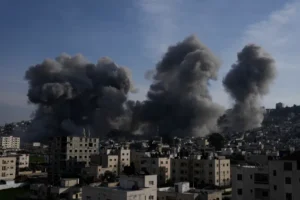The Gazafication of Jenin will not succeed

Smoke rises following Israeli army attacks, which destroyed buildings in the Jenin refugee camp in the occupied West Bank on 2 February 2025
Ahmad Ibsais writes in Al Jazeera on 11 February 2025:
Last month, as the Israeli army started pulling out of Gaza under the ceasefire agreement, it announced an “operation” in the occupied West Bank city of Jenin and its refugee camp. For three weeks now, it has been terrorising the Palestinian people there, using fighter jets, helicopters, tanks, drones, and bulldozers to kill and destroy.
Emboldened by the world’s indifference, the Israeli government is clearly attempting to replicate Gaza in the West Bank. But the Gazafication of Jenin and other refugee camps in the West Bank is bound to fail, just as similar brutal strategies have failed in the past.
There is a reason why Israel picked Jenin for the start of its renewed bloody assault on the West Bank. The camp, which was established in the aftermath of the Nakba to house 8,000 Palestinians violently expelled from their homes by Zionist forces, has been an incubator of resistance for decades.
During the first Intifada, it became one of the nuclei of Palestinian organising and resistance. The youth who had known nothing but occupation became its voice, its fist, its heart. During the second Intifada, Jenin once again served as a hub of the resistance. In April 2002, the Israeli army invaded the city, murdering 52 Palestinians, destroying hundreds of homes, and displacing more than a quarter of the population.
Israel declared victory then, claiming to have crushed “terror”. Yet, from the ruins of Jenin, a new generation rose, carrying on the unshakeable will to resist. In the 2020s, armed resistance activity intensified in Jenin and other refugee camps in the West Bank. This culminated in another brutal Israeli assault on the city in July 2023, just months before the outbreak of the genocide in Gaza. The operation involved the deployment of fighter jets, armed drones, tanks, bulldozers, and thousands of troops. The Israeli army killed at least 10 Palestinians, destroyed homes and infrastructure, and displaced thousands. And yet, resistance re-emerged once again and responded to calls from Gaza for mobilisation.
Jenin has become a hub of resistance for a reason. Refugee camps are not merely places where the displaced survive – they are the beating hearts of Palestinian consciousness. These are places where the wounds and trauma of the Nakba are passed from generation to generation, where sons and daughters inherit their parents and grandparents’ desire to return home.
Children grow up seeing their neighbourhoods raided, friends detained or murdered, just like 10-year-old Saddam Rajab from Tulkarem who was shot in the abdomen by an Israeli soldier on January 28 and the ambulance carrying him was blocked by Israeli troops at a checkpoint. Saddam died 10 days later.
